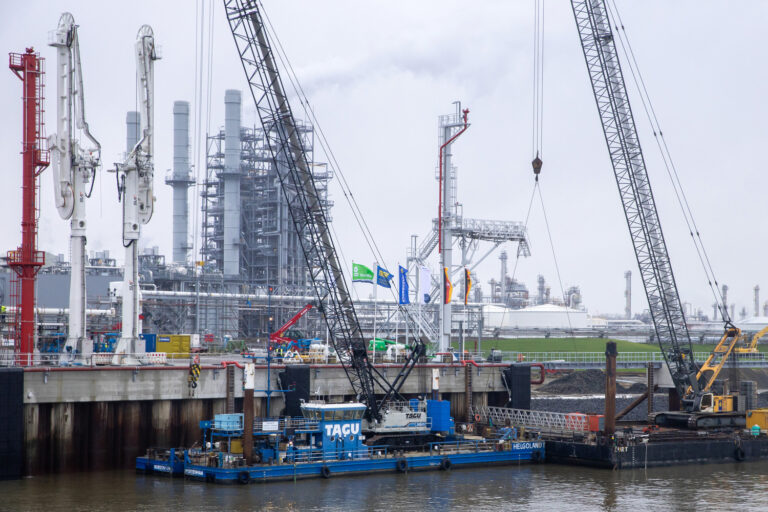
The construction of the pier in Lower Saxony officially began on January 20, 2023. Following the launching of the LNG terminal in Wilhelmshaven, the pier in Stade is the second port facility that Niedersachsen Ports has put into operation in a very short time to support Germany’s gas supply.
The new LNG jetty is 650 meters long and is located to the south of an existing harbor. Its construction was accelerated to allow an FSRU chartered by the German government to temporarily dock at Stade. The FSRU will be operated by Deutsche Energy Terminal GmbH (DET) on behalf of the German government and, according to DET, is scheduled to dock in Stade in February. The FSRU will leave Stade once the onshore terminal becomes operational.
“With the jetty in Stade, we have already proven for the second time within a year that we can deliver reliably and thus make our contribution to the security of Germany’s energy supply. My thanks go to the teams on site who worked tirelessly to realize the liquefied gas pier in just one year. In Stade, we have expanded the maritime infrastructure in Lower Saxony,” Holger Banik, Managing Director of Niedersachsen Ports and JadeWeserPort Realisierungs, commented.
“Here, as Lower Saxony, we are showing once again that we are not only prepared to take responsibility for a safe and independent energy supply for all of Germany. Above all, we show that we deliver – and continue to do so at the proverbial new German speed,” Olaf Lies, Lower Saxony Minister for Economic Affairs, Transport, Construction and Digitalization, pointed out.
“This new port infrastructure was planned and built in such a way that it can be used comprehensively and in the long term. Initially, the jetty can be used for an FSRU to regasify imported LNG and make it available for gas supply. The port infrastructure is then used to import LNG via a fixed, land-based LNG terminal.”
Lies added the promise that the use of fossil gas is only a temporary solution is being fulfilled. He said that in the next step, Germany will import climate-friendly gases via this infrastructure.
“By building the LNG infrastructure, we are also laying the foundation for a climate-neutral Lower Saxony. In the future, AVG Stade will enable the import of regeneratively produced, climate-neutral gases and thus an exit from dependence on fossil energy sources,” Christian Meyer, Lower Saxony Minister for the Environment, Climate Protection and Energy, noted.
The pier in Stade is considered to be the largest waterside construction project in Germany’s ports. With an investment of €300 million, it is also the largest project in the history of Niedersachsen Ports. In just around eleven months, a new structure was built on four hectares of water. The berth has a draft of up to 16.4 meters and the length of the quay measures a total of 1.6 kilometers.
The jetty and associated superstructure are designed to be convertible on a modular basis to hydrogen-derived energy sources similar to the building block approach used in power and energy systems.
The land-based HEH import terminal
In parallel to the water-based terminal, a land-based terminal has been planned since 2019. The project has been developed by Hanseatic Energy Hub (HEH).
The terminal is scheduled to be completed in 2027 and will handle 13.3 billion cubic meters of green and LNG gases annually.
Until then, the newly built port infrastructure will be used to import and regasify liquefied gas via an FSRU.
Initially, this will be LNG gas, but later on, renewable gases such as green hydrogen and ammonia will also be handled.
On behalf of the federal government, DET operates the 2021-built FSRU Transgas Force, owned by Greek shipping company Dynagas. The FSRU has an average annual capacity of five billion cubic meters for LNG landing, storage and regasification.
The ship is scheduled to dock in the new port area of Stade-Bützfleth in early 2024.
Stade approved as first land-based terminal to be ammonia-ready
Coinciding with the completion of the new jetty, HEH informed it has finalized its permitting and marketing phase for the onshore zero-emission terminal in the Hamburg metropolitan region. The shareholders are now preparing the final investment decision, which is expected in the coming weeks. From 2027, LNG and green energy sources such as Bio-LNG and Synthetic Natural Gas (SNG) will be handled in Stade.
HEH is the first land-based terminal in Germany to be approved as being ammonia-ready in line with Germany’s LNG Acceleration Act. Operations in Stade are to be converted from LNG to ammonia as a hydrogen-based energy source by December 31, 2043 at the latest. The technical concept was confirmed by the Federal Institute for Materials Testing (BAM) as part of the official permitting procedure under the Federal Immission Control Act (BImSchG).
HEH has also completed the commercial marketing of Germany’s largest terminal project. With EnBW, SEFE and Czech company ČEZ, three major energy suppliers will use Stade as an energy hub from 2027, thus jointly contributing to securing European energy supplies. All long-term bookings include the option to switch to ammonia.